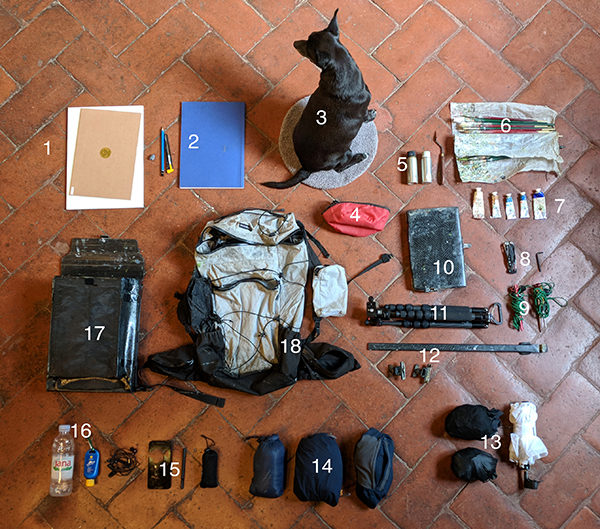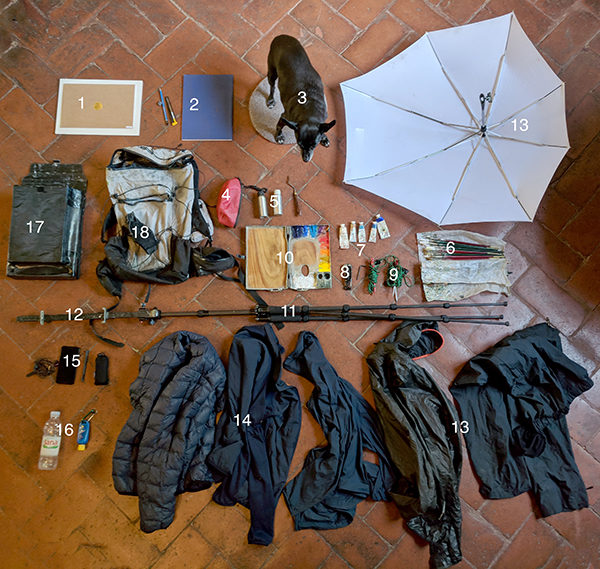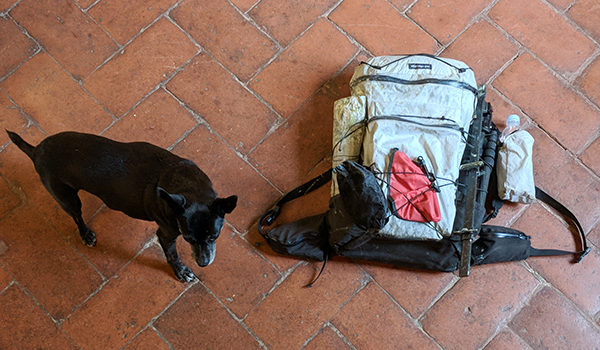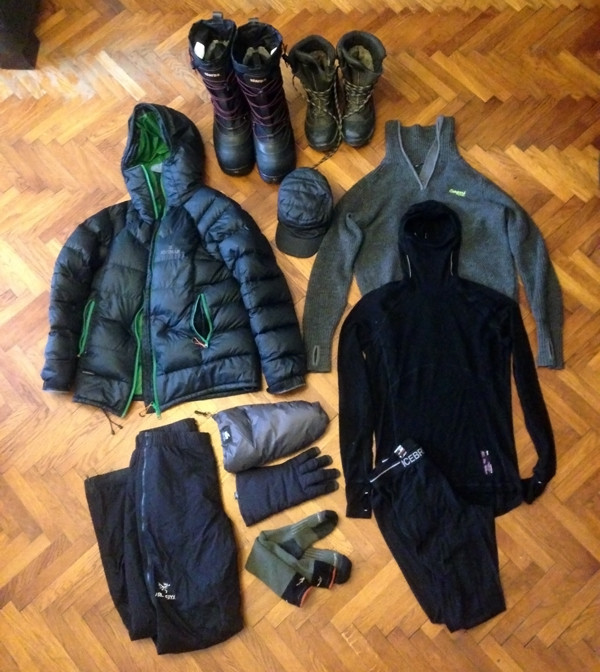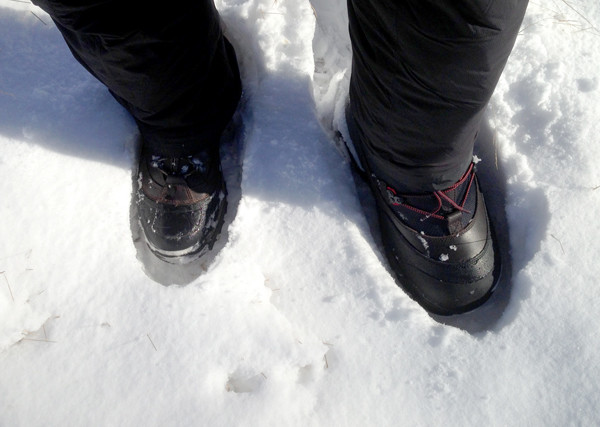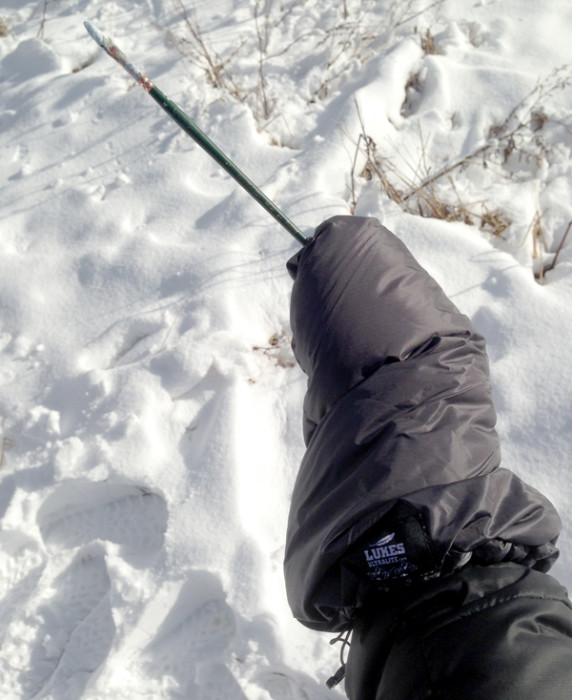- Foam-core panels with mounted linen.
- Drawing materials: Sketchbook, pencil, blade for sharpening, kneaded eraser.
- Small dog.
- Water bowl for the dog.
- Medium, thinner, and palette knife.
- Brushes (Zecchi series 102 sables and Cornelissen series 44 bristles).
- Extra blues, titanium white and Roman ochre.
- Multitool and allen key.
- Tent pegs.
- Custom carbon fiber pochade box.
- Sirui t-025x tripod. (The Sirui 5C is the same but newer and cheaper. I have both).
- Custom carbon fiber mast and panel clips.
- Rain pants, rain jacket, and umbrella with home-made attachment (situational).
- Down jacket, fleece, and windbreaker (situational).
- Phone, headphones, backup battery and stylus.
- Water and sunblock.
- Custom carbon fiber panel holder (takes two sizes).
- KS Ultralight backpack.
Most of my gear is normal painting equipment but I’ll go over some of the things.
1. New Traditions Gatorfoam panels with Claessens linen work very well. The glue never comes undone, even if the panels are left in a car window in August (I’ve tried it).
2. Kunst & Papier sketchbooks have the best paper of any I’ve found, and the paper binding makes them lighter than hardcover sketchbooks.
5. I use a Canada balsam/sun-thickened linseed oil mix for my medium, and lavender essence for my thinner. These aluminum bottles aren’t great as they start to leak after a year or so. I’m still on the lookout for a better system.
6. My set-up would be much lighter if I could learn to use fewer brushes. There are some very good painters out there who use one or two brushes for an entire oil painting. I don’t know how they do it.
7. Cadmium paints last a week on my palette, so I only bring tubes of the three blues I use (cobalt, ultramarine, cerulean), ochre, and titanium white. I go through a lot of those colors.
8. I probably use the Leatherman Skeletool once a year, and most times don’t carry it. Same with the allen key, once I get the proper tightness on the legs of the tripod I don’t really need it.
9. Most of the time the weight of the backpack and a water bottle is enough to keep the easel steady while I paint. In high winds the tent pegs work great. If I can’t get them into the soil I tie them to rocks or even lampposts or signposts in cities.
10. My next blog post will be on making a custom carbon fiber pochade box, mast set-up, and panel carrier (#12 and #17).
11. The Sirui t-025x tripod is the lightest tripod I could find that had decent stability and got up high enough for painting equipment.
13. For a rain jacket I really like the new Gore-Tex Shakedry jackets as they still breath even when you’re drenched in heavy rain. My previous jackets would ‘wet out’, meaning the face fabric would get soaked with water and keep the membrane from breathing, and the jacket would feel stuffy and suffocating in warm rain. This one breathes so well that I’ve even worn it in the summer as a bug jacket. The downside to the Arc’teryx version that I have is that the zipper leaks in really heavy rain. Other brands make them with better zippers. My umbrella is a Senz storm umbrella with a custom attachment that I made for the mast of my easel. It keeps the rain off of the painting and the palette, but unfortunately dumps it onto me while I work.
14. For carried clothes, the fleece/down/windbreaker jacket combo works great. Obviously I only take what I think I’ll need, but for shoulder seasons and places where the temperature can change dramatically (cough * the California coast * cough) the three layers give me a lot of versatility. Also, the dog gets cold quicker than I do, so she usually sleeps wrapped in one of the layers. In the past I carried a down vest rather than a jacket and I think vests are great for painters as allows for more mobility with our painting arms. And on the subject of shoulder mobility, climbing clothes are usually stitched differently so the sleeves can be raised easily. I find they work better than city or street clothes with the sleeves stitched in the ‘arms down’ position where you fight the fabric to raise your arm. It’s not a huge deal, but something to consider. All my shirts, jackets, and hats are black, dark grey, blue or dark blue so as to not reflect a confusing color back onto my painting when working contre-jour.
15. My current phone is a first generation 5″ Google Pixel. I wanted the larger storage (128GB) for shooting video while I travel, a high quality camera, and I prefer a headphone jack to the bluetooth-only design of newer phones. A powerbank is very useful for charging my phone when I forget to charge it at home, and the stylus works as a backup pencil if I need to sketch. In reality I almost never use it.
18. The KS Ultralight backpack works very well, but it’s not 100% waterproof. My worry with backpacks is that my medium will leak out, not that water will get in, so I’ve added an inner liner to the outer pocket where my pochade box goes.
This is still a work in progress, but I have arrived at a point where I don’t feel I can improve on anything in particular for the moment. Everything works great, and weighs as little as possible. My next goal is to get a similar set-up for carrying and working on very large plein air landscapes and I’ve almost got that working as well, so stay tuned.
